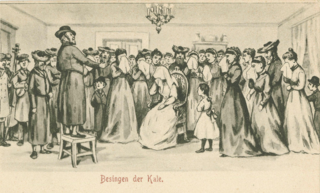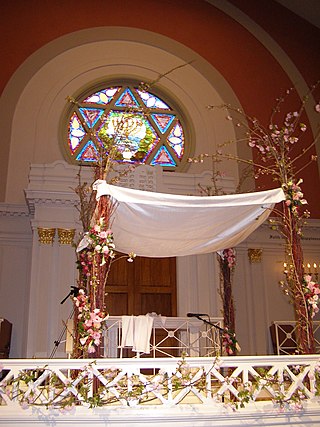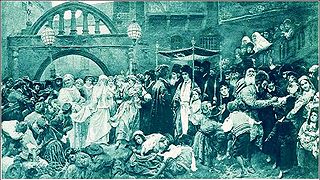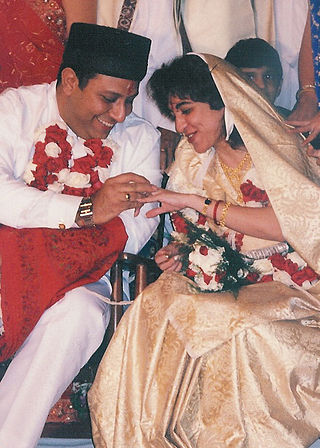
A wedding is a ceremony where two people are united in marriage. Wedding traditions and customs vary greatly between cultures, ethnic groups, religions, countries, and social classes. Most wedding ceremonies involve an exchange of marriage vows by a couple, presentation of a gift, and a public proclamation of marriage by an authority figure or celebrant. Special wedding garments are often worn, and the ceremony is sometimes followed by a wedding reception. Music, poetry, prayers, or readings from religious texts or literature are also commonly incorporated into the ceremony, as well as superstitious customs.

An engagement or betrothal is the period of time between the declaration of acceptance of a marriage proposal and the marriage itself. During this period, a couple is said to be fiancés, betrothed,intended, affianced, engaged to be married, or simply engaged. Future brides and grooms may be called fiancée (feminine) or fiancé (masculine), the betrothed, a wife-to-be or husband-to-be, respectively. The duration of the courtship varies vastly, and is largely dependent on cultural norms or upon the agreement of the parties involved.
The Shidduch is a system of matchmaking in which Jewish singles are introduced to one another in Orthodox Jewish communities for the purpose of marriage.
Blood Wedding is a tragedy by Spanish dramatist Federico García Lorca. It was written in 1932 and first performed at Teatro Beatriz in Madrid in March 1933, then later that year in Buenos Aires, Argentina. Theatre critics often group Blood Wedding with Garcia Lorca's Yerma and The House of Bernarda Alba as the "rural trilogy". Garcia Lorca's planned "trilogy of the Spanish earth" remained unfinished at the time of his death, as he did not include The House of Bernarda Alba in this group of works.

A ketubah is a Jewish marriage contract. It is considered an integral part of a traditional Jewish marriage, and outlines the rights and responsibilities of the groom, in relation to the bride. In modern practice, the ketubah has no agreed monetary value, and is seldom enforced by civil courts, except in Israel.

A badchen or badkhn is a type of Ashkenazic Jewish professional wedding entertainer, poet, sacred clown, and master of ceremonies originating in Eastern Europe, with a history dating back to at least the sixteenth or seventeenth century. The badchen was an indispensable part of the traditional Jewish wedding in Europe who guided the bride and groom through the stages of the ceremony, act as master of ceremonies, and sing to the bride, groom and in-laws with the accompaniment of klezmer musicians. They also had a traditional role on holidays such as Hanukkah or Purim. Today they are primarily found in Chassidic communities.

A kittel is a white linen or cotton robe worn by some religious Ashkenazi Jews on holidays, in the synagogue or at home when leading the Passover seder. Kittels are sometimes worn by grooms. It is also customary for Jews to be buried in a kittel.

A chuppah, also huppah, chipe, chupah, or chuppa, is a canopy under which a Jewish couple stand during their wedding ceremony. It consists of a cloth or sheet, sometimes a tallit, stretched or supported over four poles, or sometimes manually held up by attendants to the ceremony. A chuppah symbolizes the home that the couple will build together.

A Jewish wedding is a wedding ceremony that follows Jewish laws and traditions. While wedding ceremonies vary, common features of a Jewish wedding include a ketubah which is signed by two witnesses, a chuppah or huppah, a ring owned by the groom that is given to the bride under the canopy, and the breaking of a glass.
Golem is a rock-klezmer band from New York City. They mix traditional Eastern European Jewish music with original material sung in Yiddish, English, Russian, as well as Ukrainian, French, Serbo-Croatian, and Romany. The group describes itself as "Where Eastern Europe Meets the Lower East Side" and uses avant-garde spectacle to both challenge and embrace the stylistic norms of klezmer music.

A Zoroastrian wedding is a religious ceremony in Zoroastrianism in which two individuals, a man and a woman, are united. In Zoroastrianism, marriage within the community is encouraged, and is greatly favored in religious texts. The following information will detail ceremony procedures and traditional processes for a Zoroastrian wedding.
Posthumous marriage is a marriage in which at least one of the participating members is deceased.
In Chinese tradition, a ghost marriage is a marriage in which one or both parties are deceased. Other forms of ghost marriage are practiced worldwide, notably in France, since 1959. The origins of Chinese ghost marriage are largely unknown but reports of it being practiced today can still be found.
Chaim Elozor Wax was a well-known Hasidic rabbi, posek, and a Jewish leader in Poland. He was a philanthropist and accomplished student of the Talmud.
Arabic weddings are ceremonies of matrimony which contain Arab influences or Arabic culture.
In the United States and Canada, weddings follow traditions often based on religion, culture, and social norms. Most wedding traditions in the United States and Canada were assimilated from other, generally European, countries. Marriages in the U.S. and Canada are typically arranged by the participants and ceremonies may either be religious or civil. There is a tradition that the prospective bridegroom ask his future father-in-law for his blessing.

Traditional marriage customs in the Philippines and Filipino wedding practices pertain to the characteristics of marriage and wedding traditions established and adhered by them Filipino men and women in the Philippines after a period of adoption courtship and engagement. These traditions extend to other countries around the world where Filipino communities exist. Kasalan is the Filipino word for "wedding", while its root word – kasal – means "marriage". The present-day character of marriages and weddings in the Philippines were primarily influenced by the permutation of Christian, both Catholic and Protestant, Hindu, Islam, Chinese, Spanish, and American models.

Traditional Hajong marriage is a ceremonial ritual that involves a marriage established by pre-arrangement between families. Within Hajong culture, romantic love and widow re-marriage was allowed, and monogamy was the norm for the Hajong people.
Avram Mlotek is an American rabbi, social activist, cantor, writer, actor and slam poet. Mlotek is the co-founder of Base, a pluralistic home-centered outreach program, established in nine cities worldwide, predominantly for Jewish young adults.
Shaarey Zedek Cemetery is a Conservative Jewish burial ground in the North End of Winnipeg, Manitoba, Canada. Operated by the Shaarey Zedek Synagogue, it is the largest Jewish cemetery in the Canadian Prairies, with more than 8,000 graves as of 1996. In 2012, a Jewish interfaith burial ground was installed in a fenced-off section with a separate entrance to accommodate interment of Jews alongside their non-Jewish spouses. The cemetery features a war memorial honoring Winnipeg residents who fell in World War I and World War II.










